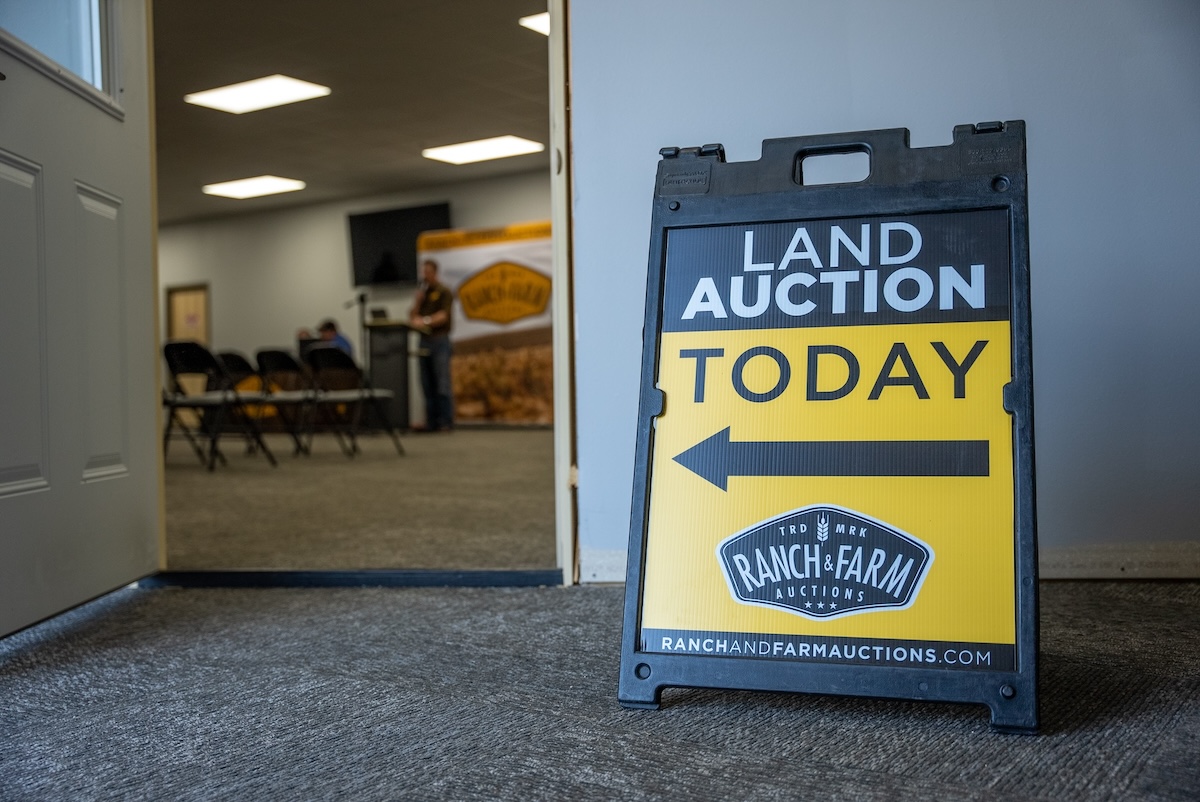
Top 10 Tips for Maximizing Your Land Auction Success
The auctioneer kicks off the auction, and the bidding war begins. His chant riles up the crowd, and all interested parties alternate bidding. The number keeps jumping, and so do your jitters. Fortunately, you've educated yourself, prepared well, and this auction is the one for you.
Of course, pre-auction prep is a must. Once at auction, there's much to know and do, too. Then, don't forget about the post-auction checklist. Bidders must be fluent in each phase of auction prep, attendance, and follow through. Here are 10 tips for maximizing your land auction success.
Editor's Note: This is not financial, investment, legal, or real estate advice. Consult with a financial planner, investment specialist, real estate lawyer, and real estate professional before buying or selling land at auction.
1. Attend Auctions to Gain Experience
New auction goers should attend "practice" auctions. Of course, these are real auctions, where real people conduct real bidding. That said, you're there as an observer only. Study the general auction procedures, typical terms and conditions, bidding process, and other elements of the auction. This educates you on the process, minimizes anxiety bidders sometimes experience, provides tools for eventual auction participation, and more.

2. Research the Property Going to Auction
It's vital to do due diligence prior to attending an auction. Therefore, research the property going to auction. Oftentimes, this is a lengthy process, and it can require plenty of research. This requires multiple steps.
Step 1: Study the property listing and legal descriptions. Study the property listing location, description, photos, maps, and other important details. This helps decide if you're interested, and if further action is required.
Step 2: Check zoning laws. Depending on your intentions and projected use of the property, zoning might conflict with that. Ensure that it doesn't by checking zoning regulations.
Step 3: Dive into potential environmental concerns. Is there a dairy farm or factory upwind (in regard to the prevailing wind direction)? Are there potential environmental pollutants nearby? Ensure there aren't any potential environmental concerns you aren't comfortable with.
Step 4: Analyze the property's access. Is it suitable for your personal needs? Is the entryway large enough for farm machinery? Is the direction right for hunting entry and exit routes? These are important questions to answer.
Step 5: Finally, visit the site. If all elements of virtual assessment check out, it's time to visit the property. Contact the auctioneer and request a property visit. They should provide further instruction for a site tour.
Step 6: Study the topography. As noted above, anticipated and projected land use is a significant factor in whether the land works for goals, or not. Topography is part of that and must be considered when walking the landscape.
Step 7: Inquire about neighboring landowners. No one wants a bad neighbor. While you're unlikely to receive detailed descriptions of every neighbor, asking around might unveil positive or negative reports that you should know about.
Step 8: If possible, conduct official appraisals and inspections. This isn't always allowed, or prudent, but circumstances permitting, are good to complete. Follow through especially if seriously interested in the property.
3. Research the Auction House Selling the Property
Each auctioneer is different. Most follow similar practices, but nuances vary from one to the next. Therefore, research the auction house selling the property. Visit its website, social media pages, and more. If you have specific questions, contact them via email or phone.
Additionally, study the auction terms and conditions. These are the rules under which the auction takes place. Therefore, knowing the terms and conditions is a crucial prerequisite to attendance. Of course, if you miss this step, the auctioneer will read through these again before the auction begins.

4. Study Comparable Properties Nearby
Those who place offers on traditional listings tend to analyze recent comps (similar property types and values) nearby. This assists with making a fair offer on a property that's for sale. The same should be done before attending an auction.
Plus, it's possible for sellers to underprice their reserves. Similarly, it's common for bidders to over- or under-value the property at auction. Doing your homework elevates your knowledge and position as a buyer.
5. Consult with a Bidder's Agent
With traditional real estate, sellers and buyers alike seek representation. With auctions, most individuals don't think about a buyer's rep, though. Instead, consult with a bidder's agent. They can provide advice, or even bid for you, on the day of the auction. Oftentimes, they have more experience, and can advise on when to bid, how to bid, and what tactics to use. Essentially, they'll help devise a strategic plan. Additionally, they can provide you with a layer of anonymity, especially if you don't want other auction attendees to know you're bidding.

6. Set a Maximum Bid Budget
Most of the above steps are designed to complete due diligence. The ending step of that process is setting a maximum bid budget. This is the most that the property is worth (to you), and that which you can comfortably afford. Never exceed what the property is valued at, or that you can comfortably afford. Don't exceed the maximum, even if your pride or goals urge it.
7. Arrive at the Auction and Settle In
On the day of the sale, arrive well before the auction begins. Spend some time walking around and familiarizing with the auction setup. Find the registration booth, sale tent, concession stands, property mapping, and more. If you have any additional questions, ask the auctioneer, or another auction worker.
Then, calm your nerves. Bidding will soon begin, and you need a clear head. Emotions can get the best of an auction attendee, but that won't be you. You came with a plan. Now, it's time to execute it.

8. Bid in a Strategic Manner
The auctioneer represents the seller. It's their job to get the seller the best price possible. Auctions are designed to create competition, excite bidders, and drive prices up to market value.
As noted above, much strategy is involved with auction bidding. Depending on the scenario, bidders might choose one tactic over another. Oftentimes, tactics vary based on number of attendees, strength of present bidders, and more.
Sometimes, it pays to kick off the bidding yourself. This can set the pace and show all auction attendees that you mean business. You're serious about the sale, and if they plan to outbid, it's going to take some serious hand-raising. This is ideal for knocking out hesitant bidders right out of the gate.
Other times, it's better to wait and let the bidding begin slowly. If there aren't many bidders present, and you come out strong, this might just drive up prices on yourself. Instead, consider waiting around for it to get going, and then join in the bidding.
Another method is to slow down the increments. Oftentimes, if the bidding slows, the auctioneer reduces the increment jumps. If the bidding is rapid, increments increase. By refusing to bid, or taking longer to do so, it can slow the bidding down, which is in the favor of bidders.
Conversely, if there's one or two more competing bidders that "won't go away," consider throwing a knockout bid. Don't wait on the auctioneer. Instead, jump the bidding up yourself. That said, only use this method if you haven't met the price ceiling, or your budget, set before the auction.
Bidding tactics aside, remember that, when bidding, it's all about reading the room. Study the other bidders' behaviors, body language, and more. Regardless of the tactics used, bid with confidence. This displays your seriousness, and that you won't be easy to outbid.
9. Control Your Emotions
Emotional awareness, intelligence, and control are vital for auction bidding success. Controlling emotions, and not allowing these to cloud judgement, is a cornerstone of financial success, of which real estate falls under.
As stated above, auctions are designed to maximize sale price. The very nature of auctions creates a competitive environment. This can spur bidders to keep going, even when they shouldn't. So, keep yourself, and those with you, in check.
If needed, ask the auctioneer for a break. Oftentimes, auctioneers are willing to grant this, especially if you need to verify numbers, check with partners, etc. Regardless of the situation, don't let pride, fear of missing out (FOMO), or other negative elements, impact your mental or emotional clarity.

10. Complete the Post-Auction Checklist
The bidding is complete, and the auction is over. If you didn't finish with the top bid, that's OK. It wasn't the right property or time for you. Keep attending auctions until your moment arrives.
However, if you won the top bid, the next phase of auction attendance begins. If the bid met or surpassed the reserve, all should be well. (The same is true for absolute auctions, as there was no reserve to meet.)
In contrast, if you had the top bid, but it didn't meet the reserve, what then? Meet with the auctioneer and seller. Oftentimes, you'll have the first opportunity to negotiate with the seller. If you reach a deal, congratulations. A purchase agreement isn't guaranteed, though.
Once you've won the bid, and the seller permits the sale, it's time to review the contract. Read through all documents to ensure the terms are acceptable. Generally, it's best that a real estate lawyer reads and approves the purchase contract and other legal documents.
For landowners looking to sell at auction, contact Ranch & Farm. We can answer questions and help with your auctioneering needs.
Published on 2025-02-03